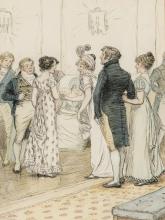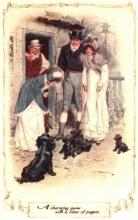inspiration + perspiration = invention :: T. Edison ::
With Chapter 10 posted both here and across the Internet, all my readers are now a third of the way through my novel. As we savor this act drawing to a close and fear what may come next, let's look at Northanger Abbey's own structure, and what we can learn about dramatic action from it.
Anyone who's looked into writing tips at all has likely heard of breaking a plot down into three acts. Maybe you remember the idea of "rising action," "climax," and "falling action" from English class. No every story obeys these rules. Still, the idea is useful not only to understand the pacing of a vast majority of modern Western cinema, but how almost any author introduces, develops, and concludes a work.
This novel's titular house actually plays a largely background role up the first two thirds of the book; until Chapter 20 everything happens in Bath. Compare this placement to its sister novel Persuasion, a book with fewer chapters (24 instead of 31) but more words (8,3274 over 7,6923). That book features three distinct settings: Kellynch Hall and the Musgrove homes to setup the primary characters and conflict, then Lyme for the big climax, and finally on to Bath for the finale. It may be that by the time Austen wrote Persuasion much later in life, she had decided to more firmly define her story's acts through differing locations. But Northanger Abbey still progresses through several journeys, even if not always to a new physical space.
If we define Act I of Northanger Abbey as Chapters 1-10, then we see that Austen spends a good amount of time presenting each of her characters to the reader, especially the protagonist. Chapter 1 is entirely devoted to Catherine Morland's background, far more biography than we receive for Elizabeth Bennet, the Dashwood sisters, or even Emma Woodhouse. It's not until Fanny Price that we get an even more detailed description of a heroine's upbringing and early family life. The Allens are also presented as fully defined characters (I always cackle at the description of Mrs. Allen, with her "harmless delight in being fine.")
 Chapter 8 illustration by Hugh Thomson (1897).
Chapter 8 illustration by Hugh Thomson (1897).
We meet Henry Tilney in Chapter 2, but learn very little about him before he disappears for many pages after. Instead, Austen's spends the majority of the first act introducing us to the Thorpe family. In fact, by the time the Tilneys step back into the narrative in Chapter 8, we know far more about John Thorpe's personality, tastes, and manner of courting. He's all flash and dash, but more present than the erstwhile hero, and presented by none other than Catherine's brother as a romantic interest.
In fact, when Henry asks her to dance a second time, there's no real rivalry between the potential sutiors: Catherine had already accepted Thorpe's hand before knowing the Tilneys would be present, and however much she might wish to join the mysterious rector, he's hardly been available to become more than an object of speculation. It's not until Chapter 10, the final moment of Act I, that we see any competition between the two, as Catherine seeks to gain Henry's attentions and Thorpe attempts to interrupt their dancing. And it's here, with the romantic (tri)angle firmly established, that we meet the next shadowy figure to impact Catherine's life: General Tilney, Henry's father.
Act II of Northanger Abbey, if we view it is Chapters 11-19, sets the playing pieces introduced in Act I in motion, not through a change of scene, but more a change in awareness by Catherine. The Thorpes transform from desirable companions into obstacles to her growing familiarity with the Tilney family. Mrs. Allen's presence and influence decreases as General Tilney's grows. By the time Act III rolls around in Chapter 20, a total break from the milder beginning takes Catherine both bodily and metaphorically to another world as she must learn to face the potential dangers of both external and internal dilemmas on her own.
Let's see how well my book, with the same number of chapters, measures up to its source material, at least so far as the first act is concerned. As can be seen by the latest updates, I move the action to Northanger Abbey much sooner, as early as Chapter 9. What's different this time around?
 Chapter 26 illustration by CE Brock (1907).
Chapter 26 illustration by CE Brock (1907).
One of the best parts of fan fiction is the ability to leap straight into the story; for authors who struggle to introduce characters or describe settings, a lot of the work is already done. Readers are likely already familiar with who the primary characters are: Henry and Catherine don't need as long an introduction, and while Woodston is less detailed in the novel, any fan of Northanger Abbey knows enough to understand where they are. I provided a short primer in Chapter 1 to remind readers of the cast of characters, but left most of the previous book's details there: anyone who wants to learn more can easily read or listen to it.
A pitfall of fan fiction is retreading old ground, or reversing character development. If a Pride and Prejudice sequel simply has the Darcys misunderstanding each other due to Wickham's interference, we may question the story and characterization: haven't they already gone through this one before? So in my Northanger Abbey, there are no Thorpes, the Allens and Morlands are only referred to in the background, and Catherine is not nearly as obsessed with Gothic novels as she was a few years earlier (though still an avid reader).
Instead, as I commented on another site, part of my inspiration for this story was to explore the new dynamics of the Tilney family, which Austen's book only briefly summarized toward the end:
Part of this story stemmed out of the unsettled nature of the Tilney family at the end of Northanger Abbey: the general tells his son to "be a full if he likes," giving his consent, but little else. Captain Tilney doesn't even show back up after Bath, even in a postscript. Eleanor is married but far away. Unlike the Darcys, who could just shrug away whatever relatives they don't wish to keep in company with if they chose, the Tilneys are a little more dependent: Henry's father, after all, is his benefactor as a clergyman as well, and they're not far enough away to ignore him forever. So how, exactly, does this family move forward after Henry and Catherine marry?
If we view the original and sequel as one whole narrative, if only for comparison, then the first act of my book could be seen as the end of Act II of the entire six part story. Act I would encompass Chapters 1-19 of Northanger Abbey, introducing characters, time, and place, setting up and resolving part of the conflict of that book, and developing Catherine from a small child into a potential love interest of at least two young men.

Act II, therefore, would cover Chapters 20-31 of Northanger Abbey and Chapters 1-10 of Gentlemen of Gloucestershire. The first part develops a new antagonist and setting in the form of General Tilney and Northanger Abbey, then transitions her through marriage to a new home before that status quo is disrupted.
Looking back at how I broke up Persuasion earlier, Woodston becomes the trip to Lyme for Catherine. It's a destination which restores part of her equilibrium before shifting it entirely by an emergency, throwing all her ideas of the future in chaos.
The remaining chapters of my novel, therefore, must find a way to not only resolve the challenges thrown up by my inciting incident, but also Catherine's character journey as a whole. Jane Austen began by describing her as someone who no one "would have supposed her born to be an heroine." She's young, naive, and fanciful. By the end of Northanger Abbey she's begun to separate fact from fiction. But in my story, I wanted to see her grow beyond the simple girl we started with, not by turning her into someone else, but allowing her to more fully mature than the last third of her original novel allowed.
How well do I succeed? Time and more chapters will tell.





